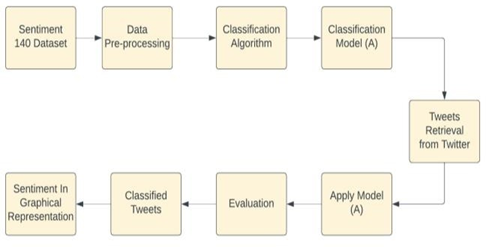Leveraging Sentiment Analysis for Twitter Data to Uncover User Opinions and Emotions
Main Article Content
Abstract
Huge amounts of emotion are expressed on social media in the form of tweets, blogs, and updates to posts, statuses, etc. Twitter, one of the most well-known microblogging platforms, is used in this essay. Twitter is a social networking site that enables users to post status updates and other brief messages with a maximum character count of 280. Twitter sentiment analysis is the application of sentiment analysis to Twitter data (tweets) in order to derive user sentiments and opinions. Due to the extensive usage, we intend to reflect the mood of the general people by examining the thoughts conveyed in the tweets. Numerous applications require the analysis of public opinion, including businesses attempting to gauge the market response to their products, the prediction of political outcomes, and the analysis of socioeconomic phenomena like stock exchange. Sentiment classification attempts to estimate the sentiment polarity of user updates automatically. So, in order to categorize a tweet as good or negative, we need a model that can accurately discern sarcasm from the lexical meaning of the text. The main objective is to create a practical classifier that can accurately classify the sentiment of twitter streams relating to GST and Tax. Python is used to carry out the suggested algorithm.
Article Details
References
Pennington, Jeffrey, Richard Socher, and Christopher D. Manning. "Glove: Global vectors for word representation." In Proceedings of the 2014 conference on empirical methods in natural language processing (EMNLP), pp. 1532-1543. 2014.
http://colah.github.io/posts/2015-09-NN-Types-FP/
https://lucid.app/lucidchart/593a533b-fb37-45ff-86ff- 6c7a6ef7e10d/edit?beaconFlowId=762A83F8A3E0FD29&invitationId=in v_37d72f1f-6f56-43ae-897a-e5b269eec2e0&page=0_0#?folder_id=recent
Theresa Wilson, Janyce Wiebe and Paul Hoffmann. Recognizing Contextual Polarity in Phrase-Level Sentiment Analysis. In the Annual Meeting of Association of Computational Linguistics: Human Language Technologies (ACL-HLT), 2005.
Alec Go, Richa Bhayani and Lei Huang. Twitter Sentiment Classification using Distant Supervision. Project Technical Report, Stanford University, 2009.
Efthymios Kouloumpis, Theresa Wilson and Johanna Moore. Twitter Sentiment Analysis: The Good the Bad and the OMG! In Proceedings of AAAI Conference on Weblogs and Social Media (ICWSM), 2011.
https://www.mygreatlearning.com/blog/word-embedding/
Shivadekar, S. ., Kataria, B. ., Hundekari, S. ., Kirti Wanjale, Balpande, V. P., & Suryawanshi, R. . (2023). Deep Learning Based Image Classification of Lungs Radiography for Detecting COVID-19 using a Deep CNN and ResNet 50. International Journal of Intelligent Systems and Applications in Engineering, 11(1s), 241–250. Retrieved from https://ijisae.org/index.php/IJISAE/article/view/2499
Mäntylä, Mika V., Daniel Graziotin, and Miikka Kuutila. "The evolution of sentiment analysis—A review of research topics, venues, and top cited papers." Computer Science Review 27 (2018): 16-32.
Zhang, Lei, Riddhiman Ghosh, Mohamed Dekhil, Meichun Hsu, and Bing Liu. "Combining lexicon-based and learning-based methods for Twitter sentiment analysis." HP Laboratories, Technical Report HPL- 2011 89 (2011): 1-8.
Rathore, R. (2022). A Study on Application of Stochastic Queuing Models for Control of Congestion and Crowding. International Journal for Global Academic & Scientific Research, 1(1), 1–6. https://doi.org/10.55938/ijgasr.v1i1.6
Ana Oliveira, Yosef Ben-David, Susan Smit, Elena Popova, Milica Mili?. Improving Decision Quality through Machine Learning Techniques. Kuwait Journal of Machine Learning, 2(3). Retrieved from http://kuwaitjournals.com/index.php/kjml/article/view/202
Sharma, V. (2022). A Study on Data Scaling Methods for Machine Learning. International Journal for Global Academic & Scientific Research, 1(1), 23–33. https://doi.org/10.55938/ijgasr.v1i1.4
Rathore, R. (2022). A Review on Study of application of queueing models in Hospital sector. International Journal for Global Academic & Scientific Research, 1(2), 1–6. https://doi.org/10.55938/ijgasr.v1i2.11
Kaushik, P. (2022). Role and Application of Artificial Intelligence in Business Analytics: A Critical Evaluation. International Journal for Global Academic & Scientific Research, 1(3), 01–11. https://doi.org/10.55938/ijgasr.v1i3.15
Kaushik P., Deep Learning and Machine Learning to Diagnose Melanoma; International Journal of Research in Science and Technology, Jan-Mar 2023, Vol 13, Issue 1, 58-72, DOI: http://doi.org/10.37648/ijrst.v13i01.008
Kaushik P., Enhanced Cloud Car Parking System Using ML and Advanced Neural Network; International Journal of Research in Science and Technology, Jan-Mar 2023, Vol 13, Issue 1, 73-86, DOI: http://doi.org/10.37648/ijrst.v13i01.009
Kaushik, P. (2023). Artificial Intelligence Accelerated Transformation in The Healthcare Industry. Amity Journal of Professional Practices, 3(01). https://doi.org/10.55054/ajpp.v3i01.630
Kaushik, P. (2023). Congestion Articulation Control Using Machine Learning Technique. Amity Journal of Professional Practices, 3(01). https://doi.org/10.55054/ajpp.v3i01.631
Rathore, R. (2023). A Study Of Bed Occupancy Management In The Healthcare System Using The M/M/C Queue And Probability. International Journal for Global Academic & Scientific Research, 2(1), 01–09. https://doi.org/10.55938/ijgasr.v2i1.36

